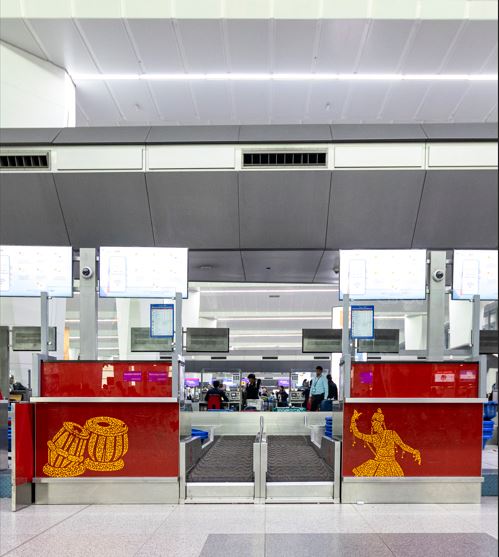
Modern airports are intricate ecosystems, handling millions of passengers, staff, and aircraft movements every year. At the heart of this dynamic environment lies the HVAC system, quietly ensuring comfort, air quality, and regulatory compliance across vast, diverse terminal spaces. But as these systems age, subtle failures can ripple across operations, inflating costs, compromising passenger experience, and breaching safety norms.
When these sophisticated systems begin showing signs of decline, the impact extends far beyond simple comfort issues - affecting everything from operational costs to passenger experience and regulatory compliance.
Airports typically rank among the highest energy consumers in the commercial sector, with HVAC systems accounting for approximately 40-60% of total energy usage. When retrofit needs arise, energy consumption patterns provide the clearest indicators of system deterioration.
Aging HVAC equipment operates with significantly reduced efficiency compared to modern alternatives. Older chillers, air handling units and distribution systems struggle to maintain design performance levels, resulting in increased energy draw to achieve the same cooling or heating output. This inefficiency manifests through several observable patterns:
Airport environments present unique challenges for maintaining consistent comfort conditions. Terminal spaces feature high ceilings, extensive glazing, variable occupancy loads and multiple microclimates that demand sophisticated control strategies. When HVAC systems begin failing to meet these demands, passenger comfort deteriorates rapidly.
Temperature inconsistencies typically manifest as hot and cold spots throughout terminal areas, with some zones experiencing uncomfortable conditions while others remain adequately conditioned. These variations often indicate failing control systems, deteriorated ductwork, or inadequately sized equipment that can no longer handle design loads.
HVAC systems operating beyond their optimal service life experience increasingly frequent breakdowns that disrupt terminal operations. Critical equipment failures can affect entire terminal sections, creating uncomfortable conditions for passengers and potentially impacting flight operations.
The pattern of frequent repairs often indicates that individual components have reached the end of their useful life and require replacement rather than continued maintenance. When repair costs begin approaching replacement costs, or when equipment availability becomes unreliable, retrofit consideration becomes financially prudent.
Equipment breakdowns in airport environments create costs that extend far beyond immediate repair expenses. Terminal area shutdowns, passenger comfort issues and potential impacts on airline operations can result in significant indirect costs that justify proactive retrofit investments.
Airports must maintain exceptional indoor air quality standards to protect the health and comfort of diverse populations including passengers, employees and service providers. Aging HVAC systems often struggle to meet contemporary air quality requirements, particularly regarding filtration efficiency, outside air delivery and contaminant removal.
Poor air quality in airport environments can result from inadequate filtration systems, insufficient outside air ventilation, or compromised air distribution patterns. These deficiencies become more pronounced as passenger volumes increase and air quality regulations become more stringent.
Effective ventilation requires proper air distribution patterns that ensure adequate air changes throughout all occupied spaces. Aging ductwork systems may develop leaks, blockages, or design inadequacies that prevent proper air distribution, creating areas with stagnant air or insufficient ventilation rates. Terminal areas with poor air circulation can experience accumulation of airborne contaminants, elevated humidity levels and uncomfortable conditions that impact passenger experience and potentially create health concerns.
Building codes and environmental standards continue evolving to address energy efficiency, indoor air quality and environmental sustainability concerns. Airport HVAC systems installed under previous code versions may no longer meet current regulatory requirements, creating compliance gaps that require addressing through comprehensive retrofits.
Modern standards often include requirements for energy efficiency minimums, ventilation rates, filtration levels and system monitoring capabilities that older installations cannot achieve without significant modifications or complete replacement. Compliance areas requiring attention:
Contemporary airport operations face increasing pressure to reduce environmental impact through improved energy efficiency and reduced carbon emissions. Aging HVAC systems typically operate with outdated refrigerants, inefficient equipment and energy consumption patterns that conflict with sustainability goals.
Retrofit projects provide opportunities to incorporate modern technologies including high-efficiency equipment, advanced controls, renewable energy integration and refrigerants with lower global warming potential. These improvements support both regulatory compliance and corporate sustainability initiatives.
Recognizing these warning signs requires systematic evaluation of existing HVAC infrastructure to determine retrofit scope and priorities. Professional assessment should include energy audits, equipment condition surveys, performance testing and regulatory compliance reviews to establish baseline conditions and identify improvement opportunities.
The assessment process should consider not only current deficiencies but also future operational requirements including anticipated passenger growth, terminal expansions and evolving regulatory standards that will impact HVAC system demands.
Retrofitting your HVAC system isn’t just about solving today’s discomfort, it’s about safeguarding tomorrow’s operations. With rising energy costs, stringent compliance norms, and elevated passenger expectations, a timely retrofit is not a choice, it’s a necessity.
“HVAC failures may not make headlines—but their impact ripples through every layer of airport operations. From disrupted passenger flow to regulatory non-compliance, the risks escalate quickly. A structured retrofit plan isn’t optional—it’s the firewall between consistent service and systemic failure.”
Roy Sebastian, CEO, GEMS
If you're considering an HVAC energy audit or system upgrade to future-proof your airport operations, drop us a mail at Rohitkumar.Singh@gmrgroup.in or get in touch with us at +91 97171 99753.